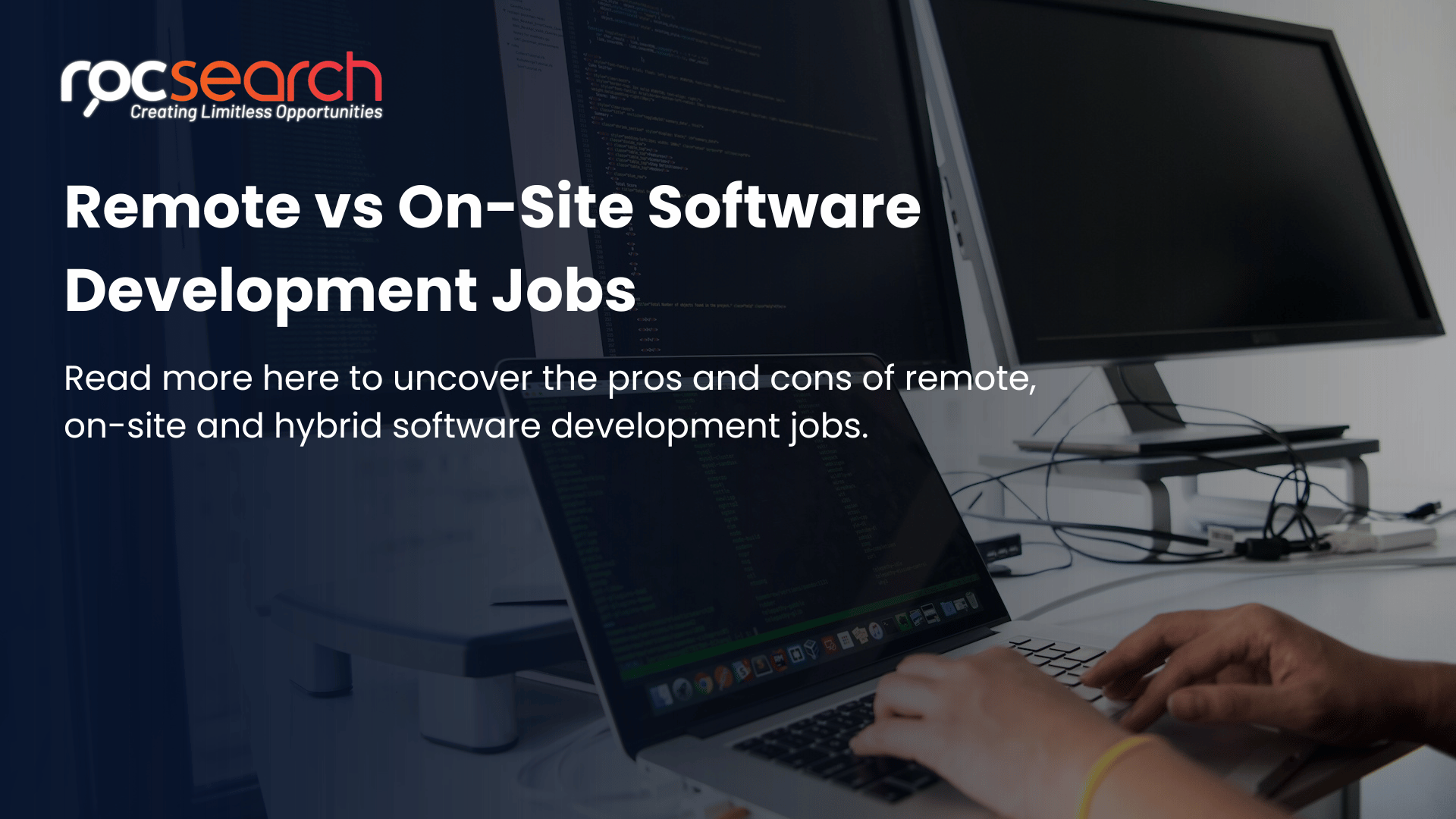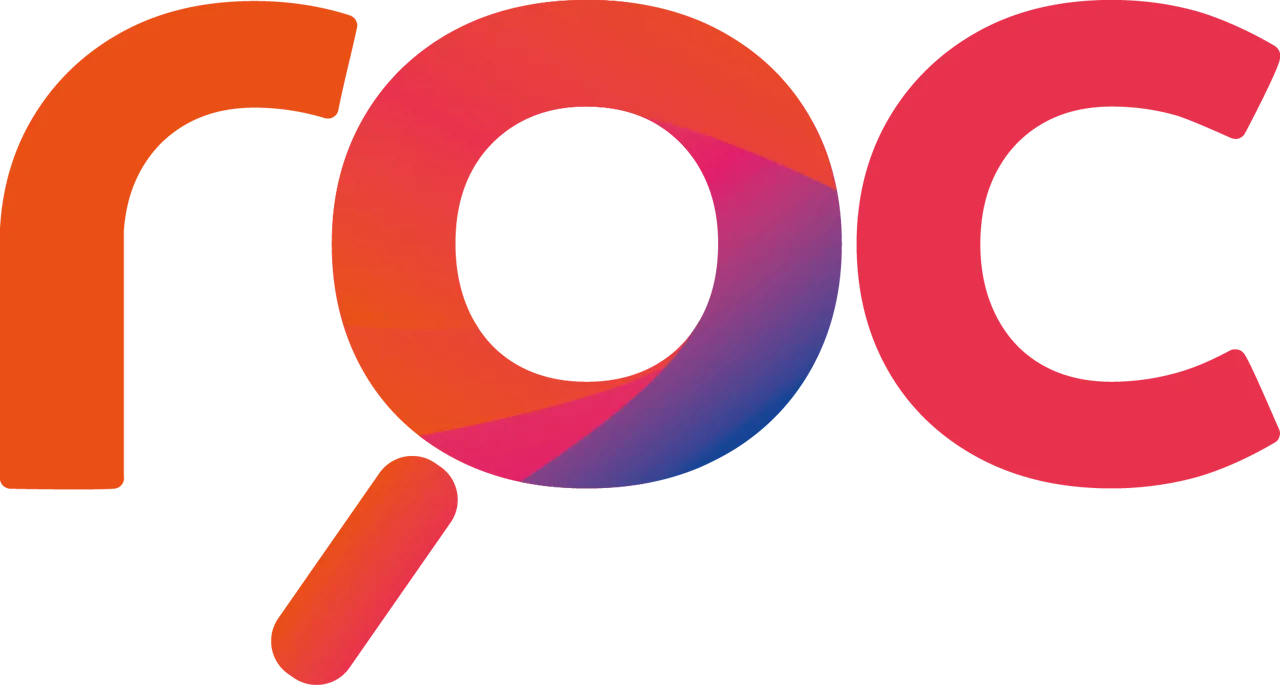Remote vs On-Site Software Development Jobs
03 Jun, 202411 minutesTraditional office environments are no longer the only option for software development jobs,...

Traditional office environments are no longer the only option for software development jobs, with a growing number of companies embracing remote and hybrid models. This newfound flexibility empowers developers to choose a work environment that aligns with their needs and personal preferences. However, with so many options on the table, making an informed decision can be challenging.
In this guide, we will discuss the pros and cons of fully remote, hybrid, and on-site models, exploring their advantages and disadvantages through company culture, team dynamics, and individual preferences. We will also uncover the red flags developers must look for in job descriptions to ensure the role suits them.
1. Remote Software Development Jobs
First, let’s dive into the advantages and disadvantages of remote software development jobs.
In software development, fully remote work is a working environment where employees perform their entire job responsibilities from a location outside of an on-site office setting. This necessitates a reliance on technology and strong communication skills to collaborate effectively with colleagues who may be located in different geographical locations.
Typical characteristics of remote software development jobs include:
Take a look below at some of the characteristics of remote software development jobs:
- Work from Anywhere - Stable internet lets you work from any location, offering flexibility and potentially better work-life balance.
- Flexible Communication -Teammates might be in different time zones, so communication relies on emails, messaging apps, and project management tools.
- Be Your Own Boss - Remote developers need strong self-management skills to manage time, stay organised, and prioritise tasks.
- Tech is Key - Cloud-based tools like code repositories, video conferencing, and project management are vital for collaboration.
- Focus on What Matters - Performance is measured by clear goals and delivering high-quality work, not by being seen in an office ("FaceTime").
What are the Pros of Remote Software Development Jobs?
With the remote working characteristics in mind, let’s explore some of the main advantages of remote software development jobs:
- Work-life balance - In a survey of 4,000 people, more than half (63%) said they would prioritise work-life balance over a higher salary. Remote work typically offers more flexibility in scheduling, where you can structure your work around personal commitments.
- Location flexibility - You can work anywhere with a stable internet connection, meaning remote software developers have the freedom to avoid long commutes and live in a location that is less expensive and closer to home.
- Increased productivity - With 83% of remote workers stating they work at the same or “higher” level than when on-site, it is evident that software developers may feel more productive in remote settings with fewer distractions.
- Wider job market - Remote software development jobs open doors to a much larger pool of potential employers. You're not limited to companies in your local area, allowing you to find the perfect job fit regardless of location.
- Reduced stress - By eliminating daily commutes and offering more control over your schedule, you get more time to focus on your well-being, leading to a balanced work-life and reducing stress.
What are the Cons of Remote Software Development Jobs?
Now that we have uncovered the pros of remote software development jobs, let’s get into the potential drawbacks of remote work settings within the industry:
- Social Isolation - The absence of in-person collaboration with other colleagues can result in feelings of isolation and loneliness. Building a strong team culture can also be more challenging in a remote setting, potentially limiting collaboration.
- Communication Challenges - Reliance on communication tools for potential time zone differences can create difficulties in real-time collaboration, leading to potential misunderstandings and delays.
- Work-Life Balance Challenges - While flexibility offers freedom, it can blur the lines between work and personal life, making it difficult to disconnect and potentially leading to burnout.
- Limited Opportunities for Mentorship - Remote developers may miss out on the informal learning opportunities and mentorship that can naturally occur through in-person interactions with senior colleagues in a traditional office setting.
- Reduced Networking Opportunities - Building strong professional relationships and connections can be more challenging in a remote environment, potentially hindering career advancement in the long run.
How to Identify Red Flags in Remote Job Postings
While remote software development offers numerous benefits, not all companies excel at creating a supportive remote work environment. Here's how to spot red flags in job postings:
Unrealistic demands
Postings that indicate excessive workload, unreasonable deadlines, or an "always-on" or “fast-paced” culture could suggest a potential lack of work-life balance for remote employees.
Communication and structure issues
Missing mentions of collaboration tools, unclear communication channels, or descriptions emphasising micromanagement software can indicate a disconnected remote work structure.
Missing details
A lack of information about remote-specific benefits (like equipment stipends) or compensation adjustments for location might signal a company not well-equipped to manage remote employees effectively.
Unprofessional language
A badly written job posting with typos or a poorly designed company website can be a red flag for a disorganised or unprofessional company culture, which can translate to challenges in remote work.
2. Hybrid Software Development Jobs
Hybrid software development jobs blend elements from multiple approaches to software development, often combining traditional on-site work with remote work or mixing methodologies and technologies to optimise productivity and innovation.
So, what are the key characteristics of hybrid jobs?
Here are the typical characteristics involved in hybrid software development jobs:
- Flexible locations - Hybrid work arrangements mean software developers can work both remotely and on-site, balancing home and office environments.
- Use of modern collaboration tools—A range of collaboration tools, such as Zoom and Slack, and cloud systems, such as AWS and Azure, allow for effective collaboration and development in software developer jobs.
- Diverse team structures - Hybrid jobs mean teams are also cross-functional and located across various geographical locations.
- Goal-oriented - As software developers partly work in remote settings, there is an increased focus on hitting project goals and deliverables to measure success and productivity.
Pros of Hybrid Software Development Jobs
The nature and characteristics of hybrid software developer jobs means that they offer several advantages:
- Good work-life balance - Hybrid work models offer flexibility, allowing you to manage personal and professional responsibilities more effectively by splitting time between home and office environments.
- Enhanced productivity - The blend of remote and on-site focused work leads to better work-life balance while providing opportunities for in-person collaboration and brainstorming sessions to enhance creativity and productivity.
- Better networking opportunity - Hybrid jobs enable you to build professional relationships both online and in person. On-site days facilitate face-to-face networking and stronger team bonds, while remote work allows for broader, virtual connections to enhance career development.
- Geographical flexibility - A hybrid work environment means you can live further from the office without sacrificing in-office days, offering a stable and adaptable work-life arrangement.
- Stronger professional relationships - Regular in-person interactions are essential in building strong relationships, meaning hybrid environments are the perfect option for reducing feelings of isolation.
Cons of Hybrid Software Development Jobs
While hybrid jobs offer several advantages, there are also potential setbacks:
- Security concerns - According to recent research, 63% of businesses have had data breaches due to hybrid working jobs and remote work systems due to dispersed workforces.
- Inconsistent work environments - Continual switches between office and home environments can affect productivity and potentially disrupt workflow and routine.
- Company culture - Maintaining a unified company culture can be more difficult with hybrid working arrangements, as separate cultures may form between in-house and remote teams.
- Connectivity issues - Hybrid software developer jobs can cause connectivity issues due to internet and software challenges for remote workers, communication gaps between remote and in-office teams, and limited face-to-face interaction.
- Management challenges - Hybrid and remote teams are typically harder to manage than on-site professionals. Employees may receive limited feedback and supervision when working remotely, raising concerns about performance management.
How to Identify Red Flags in Hybrid Job Postings
It is important to recognise any potential red flags in hybrid software development job postings to ensure you are aligned with suitable roles.
Here are the top red flags you should be aware of:
Unclear Description of Work Arrangements
If the job posting is vague about how much time you'll spend in the office versus at home, it could be a sign of confusion on their part. Make sure they clearly spell out the hybrid work structure, so you know what you are applying for.
High Emphasis on In-Office Requirements
When a "hybrid" job favours in-office work, it might not be as flexible as advertised. Double-check that their expectations match your needs if you prefer more remote work.
Inconsistency Across Different Platforms
Are you noticing different details about the job on various platforms? That could mean the company isn't on the same page internally. Consistent job descriptions are a good sign of an organised and reliable employer.
Limited Mention of Remote Work Resources
If they don't talk much about the tools and support for remote work, that's a red flag. A good hybrid role should clearly outline what resources are available to help you succeed while working from home.
3. On-Site Software Development Jobs
On-site software development jobs are characterised by structured working hours aligned with company operations and direct access to office resources, where job roles are primarily carried out in the office.
Let’s explore the typical characteristics of on-site jobs in software development in more detail:
- Fixed Working Hours - Set hours for starting and ending the workday, usually aligning with the company's business hours.
- Office-Based Collaboration - Frequent face-to-face meetings and real-time collaboration with team members.
- Access to Office Resources - Direct access to office equipment, high-speed internet, and other necessary resources.
- In-Person Training and Mentorship - Opportunities for on-the-job training, mentorship, and immediate feedback from supervisors. Around 29% of business leaders have not taken measures to track remote productivity. On-site work may make it easier for managers to monitor employee productivity and provide support wherever necessary.
- Networking Opportunities - Easier access to networking and relationship-building with colleagues and other departments.
Pros of On-Site Software Development Jobs
If you’re looking for a software developer job that provides frequent collaboration, feedback and a structured routine, onsite jobs might be the perfect option for you.
Let’s dive deeper into the advantages of working on-site in software development:
- Enhanced Collaboration - Face-to-face meetings and in-person interactions can lead to more effective teamwork and quicker problem-solving.
- Access to Resources - On-site jobs provide direct access to office equipment, high-speed internet, and other necessary tools, ensuring you have everything you need to work efficiently.
- Structured Environment - Working in an office offers a more structured and controlled environment, which can help maintain focus and productivity with fewer home-based distractions.
- Immediate Feedback and Mentorship - On-site jobs allow for immediate feedback and mentorship from supervisors and colleagues, facilitating personal and professional growth.
- Networking Opportunities - Regular in-person interactions provide greater opportunities for networking and building relationships with colleagues, which can be beneficial for career advancement.
Cons of On-Site Software Development Jobs
There is no doubt that on-site jobs in software development offer an array of benefits. However, it is important to weigh up the
- Commute Time and Expenses - Daily travel to and from the office can be time-consuming and costly, impacting work-life balance and increasing stress levels.
- Limited Flexibility - On-site roles typically offer less flexibility in terms of work hours and location, making it harder to manage personal commitments and unexpected events.
- Less Autonomy - On-site jobs may come with closer supervision and less autonomy, which can be restrictive for those who prefer a more independent work style.
- Work-Life Boundaries - Being physically present in the office can blur the lines between work and personal life, leading to potential burnout if work hours extend beyond the office.
- Potential for Conflict - On-site roles can expose employees to office politics and interpersonal conflicts, affecting job satisfaction and overall morale.
How to Identify Red Flags in On-Site Job Postings
When searching for on-site jobs, it's important to recognise any potential red flags that could indicate a problematic employer. Here are some key indicators to watch out for when reviewing on-site software developer postings.
Poor Online Presence
A reputable company should maintain a well-established online presence, including a professional website and regular social media posts. If a job posting is from a company with little or no online footprint, it can be a red flag.
Unrealistic Requirements
Be cautious of job postings with minimal qualifications for high-level roles or excessively demanding requirements for entry-level positions. Listings like these may indicate unreasonable expectations or poorly structured software developer jobs.
Urgency in Hiring with Minimal Interview Process
Job postings emphasising an urgent need to fill the position, especially without a proper interview process, should raise concerns. Legitimate employers usually have structured hiring procedures with multiple interview stages.
No Mention of Benefits and Perks
A complete lack of information about benefits, vacation time, or professional development opportunities might suggest a company with a limited or unattractive overall package.
Top Questions to Ask in Remote, Hybrid, and On-Site Interviews
Once you get to the interview stage, asking the right questions is essential. Whether you are applying for remote, hybrid, or on-site software developer jobs, it is important to be sure the working model works for you.
Remote
Here are some of the most important questions to ask your employer during an interview to ensure remote working jobs are the correct choice for you:
- ‘What is the company's policy on remote work, and for how long has the company been endorsing remote work?’
- ‘What are the guidelines for work hours and availability? Is there flexibility in setting work schedules?’
- ‘How does the company assess productivity and achievements in a remote work setting?’
- ‘What support or resources does the company offer remote employees to promote their well-being and professional development?’
- ‘How frequently are team meetings and check-ins held, and through what platforms? Is there a consistent schedule for virtual collaboration?’
Hybrid
Take a look below at some of the essential questions to ask your interviewer to help you decide whether hybrid jobs are the most suitable for you:
- ‘’What is the company's policy on remote versus on-site workdays for hybrid employees?’
- ‘How does the company ensure equal opportunities and inclusion for both remote and on-site team members?’
- ‘Can you provide examples of how the company promotes collaboration between remote and on-site team members?’
- ‘How are team meetings and communication structured to accommodate both remote and on-site employees?’
- ‘What resources and support are available to help hybrid employees transition between remote and on-site work?’
On-Site
How do you ensure on-site jobs are the best choice for you? To learn more about how on-site jobs can work in your favour and meet your needs, consider asking your employer the following questions during your interview:
- ‘What is the team's typical day-to-day workflow and collaboration process?’
- ‘What resources and tools are available to support developers in their tasks?’
- ‘Are there opportunities for professional development and career growth within the company?’
- ‘What are the expectations regarding work hours and overtime?’
- ‘How does the company build a positive and inclusive work culture?’
To learn more about how to excel in a technical interview, discover our insightful guide, How to Master the Technical Interview: A Guide for Software Developers.

Final Word on Remote vs On-Site Software Development Jobs
Choosing between remote, hybrid, and on-site software development jobs involves weighing various pros and cons to find the best fit for your career and lifestyle. Each work model offers distinct advantages and potential drawbacks.
Remote work provides flexibility and autonomy, allowing developers to work from any location. This setup promotes better work-life balance and reduces commuting stress. However, remote working jobs can lead to feelings of isolation and require strong self-discipline for effective communication and productivity.
Hybrid jobs combine the benefits of remote and on-site work, offering flexibility while maintaining opportunities for in-person collaboration and networking. This model enhances work-life balance by allowing developers to split their time between home and office. However, managing hybrid teams can pose challenges in maintaining a strong company culture and communication across different work environments.
On-site jobs build immediate collaboration, mentorship opportunities, and a structured work environment. Developers benefit from direct access to resources and face-to-face interactions, which can enhance teamwork and productivity. However, commuting and limited flexibility in work hours may impact personal time and work-life balance.
Understanding the key characteristics and potential red flags in job postings can help you make a more informed decision when choosing your ideal role.
Need Help Looking for Software Development Jobs?
Are you seeking your next career opportunity in software development? Our dedicated recruitment agency provides unparalleled guidance, insight, and support to assist you in securing your ideal role. By tapping into our extensive networks and industry expertise, we deliver exceptional solutions tailored to your needs.
Visit our software development page to learn more about our services and how we can support both clients and candidates.
Or, contact one of our consultants today to discuss your unique requirements.





